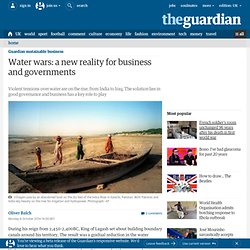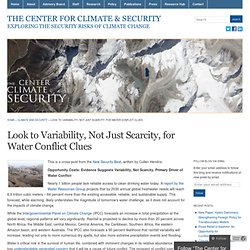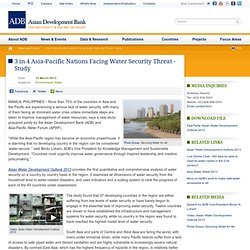

Water Wars. Right as the West is tightening the screws on Russia's energy sector, Vladimir Putin is accelerating his own pivot to the east, moving closer to another giant natural gas deal with China.

If consummated this fall, the multibillion-dollar deal would at least partially alleviate Russia's fears about finding future markets for its gas exports and China's worries over finding future energy supplies, especially natural gas, for its growing economy and population. By potentially boosting Russia's leverage with respect to Europe while dealing a blow to other gas exporters' hopes of leaping into the Chinese market, the deal's knock-on effects could be felt from Brussels to British Columbia. Miller added that, since talks with Beijing accelerated after the completion of the eastern Siberian gas deal in May, the two sides are considering increasing the western export route to as much as 100 billion cubic meters of gas per year.
So what's changed? But it takes two to tango. Guneev Sergey - Getty. UN Documentation Centre on Water and Sanitation. International Decade for Action 'Water for Life' 2005-2015. Water Wars. Water wars: a new reality for business and governments. During his reign from 2,450-2,400BC, King of Lagash set about building boundary canals around his territory.

The result was a gradual reduction in the water flowing to nearby Umma (modern-day Iraq). Fisticuffs followed. Violent tensions over water are certainly nothing new, but they are on the rise. “We see thousands of years of examples where water has been a source of tension in one form or another … but violence related to water is growing, not shrinking”, says Peter Gleick, president of the Pacific Institute, an independent US research centre that publishes a chronology of water-related conflicts. Clash of interests Basic demand-supply rules go a long way to explaining the reasons behind this growing friction.
Report: Water Shortages Crimp China Shale Gas Plan. BEIJING — More than 60 percent of China's vast shale gas deposits are in regions with scarce water resources, complicating plans by the energy-hungry country to tap the , according to a U.S.

-based research group. The World Resources Institute said China has the world's largest reserves of natural gas trapped in deep shale rock but most of it is in arid areas such as deserts or regions where farming and industry already stress water resources. Commonly known as fracking, shale gas mining requires pumping large quantities of water mixed with chemicals into deep wells to break apart shale rock. The institute said in a report issued Tuesday that 38 percent of the world's shale gas deposits are in areas with scarce water. China, Argentina and Algeria have the world's biggest shale gas deposits. China is seeking to tap its shale gas deposits to help power a growing economy and move away from polluting coal-fired energy plants.
Look to Variability, Not Just Scarcity, for Water Conflict Clues « The Center for Climate & Security. This is a cross-post from the New Security Beat, written by Cullen Hendrix.

Opportunity Costs: Evidence Suggests Variability, Not Scarcity, Primary Driver of Water Conflict Nearly 1 billion people lack reliable access to clean drinking water today. A report by the Water Resources Group projects that by 2030 annual global freshwater needs will reach 6.9 trillion cubic meters – 64 percent more than the existing accessible, reliable, and sustainable supply.
This forecast, while alarming, likely understates the magnitude of tomorrow’s water challenge, as it does not account for the impacts of climate change. While the Intergovernmental Panel on Climate Change (IPCC) forecasts an increase in total precipitation at the global level, regional patterns will vary significantly.
Modi leads India to the Silk Road. With Beijing having had a profound rethink on India's admission as a full member of the Shanghai Cooperation Organisation, the tectonic plates of the geopolitics of a massive swathe of the planet stretching from the Asia-Pacific to West Asia are dramatically shifting.

That grating noise in the Central Asian steppes will be heard far and wide -- as far as North America, says Ambassador M K Bhadrakumar. On the face of it, China has so far been reluctant about India's admission as a full member of the Shanghai Cooperation Organisation. According to latest reports, Beijing has had a profound rethink. At the SCO foreign ministers meeting last Thursday in Dushanbe, Tajikistan, a decision has been taken that the grouping will formally invite India, Pakistan, Iran and Mongolia as members at its next summit in September. To be sure, Russia would be immensely pleased. The big question remains: What made China shift its stance? Several reasons could be attributed to the 'new thinking' in Beijing. 3 in 4 Asia-Pacific Nations Facing Water Security Threat - Study.
MANILA, PHILIPPINES – More than 75% of the countries in Asia and the Pacific are experiencing a serious lack of water security, with many of them facing an imminent water crisis unless immediate steps are taken to improve management of water resources, says a new study prepared jointly by the Asian Development Bank (ADB) and Asia-Pacific Water Forum (APWF).

“While the Asia-Pacific region has become an economic powerhouse, it is alarming that no developing country in the region can be considered ‘water-secure’,” said Bindu Lohani, ADB’s Vice President for Knowledge Management and Sustainable Development. “Countries must urgently improve water governance through inspired leadership and creative policymaking.” Asian Water Development Outlook 2013. Security Challenges in Asia due to Water Scarcity.